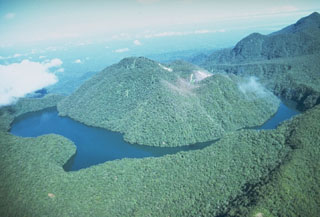Report on Loloru (Papua New Guinea) — October 1984
Scientific Event Alert Network Bulletin, vol. 9, no. 10 (October 1984)
Managing Editor: Lindsay McClelland.
Loloru (Papua New Guinea) Solfataras active on dome and flank
Please cite this report as:
Global Volcanism Program, 1984. Report on Loloru (Papua New Guinea) (McClelland, L., ed.). Scientific Event Alert Network Bulletin, 9:10. Smithsonian Institution. https://doi.org/10.5479/si.GVP.SEAN198410-255030
Loloru
Papua New Guinea
6.52°S, 155.62°E; summit elev. 1887 m
All times are local (unless otherwise noted)
"Aerial inspection showed that dome and flank solfataras were active as normal. Water temperature most recently recorded in a pool by the stream draining the caldera lake was 80°C."
Geological Summary. Loloru, the SE-most volcano on Bougainville Island, is the source of a broad ignimbrite apron that covers much of the southern part of the island. The summit consists of two nested calderas, and a forested andesitic lava dome that restricts a crescent-shaped lake to the eastern side of the younger caldera. The smooth flanks of the pyroclastic shield are dissected by radiating deep valleys. A pristine lava flow occurs on the SE flank. Loloru is constructed within the 10 x 15 km Pleistocene Laluai caldera. The topographically higher Taroka group of volcanoes to the NW and the Takuan group to the north also were constructed within the caldera and deflected the bulk of Loloru ignimbrites to the south. The most recent of several major Holocene explosive eruptions took place about 3,000 years ago.
Information Contacts: K. McCue, Bougainville Copper Ltd.

